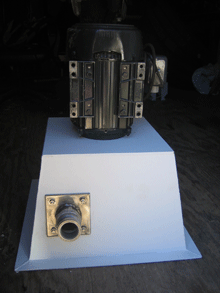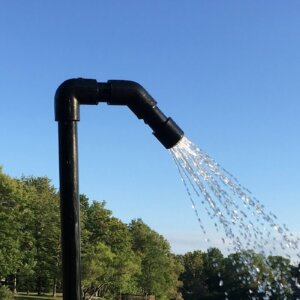As a follow up to Sean’s post on Micro Hydro Essentials, I thought I would share an overview of my system, which has powered my home for over 13 years. We are fortunate to live on rural mountain property in Northern California with a creek that is not seasonal, although the volume of water does drop significantly during the arid months of summer.
The beauty of hydropower is that it produces power 24 hours a day and is not dependent upon weather patterns, such as sun and wind. The drawbacks are having to maintain the system by cleaning the intake and dealing with varying creek flows.

17 years ago, my alternative power system consisted of one solar panel, one golf cart battery, one DC light, and one DC car stereo. Today, I live in a modern off-the-grid home complete with many large energy-using electrical appliances, such as a washing machine, air conditioner, refrigerator, vacuum cleaner, dishwasher, and baseboard heaters.
Using these appliances off-the-grid is only possible by limiting their usage to one at a time, with the exception of the refrigerator (which remains on 24 hours a day). Unlike grid-connected homes, where it is common to see multiple large loads running simultaneously, most people living-off-the grid cannot run their washing machine while vacuuming, their heaters while washing dishes, etc.
Alternative home energy systems are limited to the amount of power stored in the battery bank and what is being currently produced via wind, water, and/or sun for available power. Since hydro systems provide power continuously, the battery bank does not need to be as large as with other alternative energy systems.

Our system consists of approximately 2500 feet of two-inch PVC pipe from intake to turbine. We “borrow” water from our creek which is diverted back to the creek after running through the turbine. At the bottom of the pipe, we have 230 PSI for our static water pressure (valve closed, not running). Our dynamic pressure (running pressure) changes to 185 PSI from pipe friction loss. A four-inch pipe would greatly reduce this friction loss; however, the cost is prohibitive for us.
We run a turgo wheel coupled to a three-phase induction motor that produces 220 volts, unregulated, “wild” AC power, which is sent long distance (1500 feet) from the creek to our power shed. This power cannot be used directly in appliances because it is unregulated, but it can be used for baseboard heaters and diversion loads, such as a hot water heating element. Our system differs from most micro hydro systems which produce DC power requiring the turbine be located close to the home because of line loss and cable size needed for direct current. To get the most head (vertical fall from intake to turbine), our wheel has to be located at the bottom of our property or else we would make very little power using a traditional DC micro-hydro system close to our home (200 watts). With micro-hydro systems, a high head is more important than water flow for producing maximum power. Low head, high flow is hard to harness.

Once the “wild” electricity reaches our power shed, it is transformed and rectified to DC battery voltage and stored in our batteries like a typical alternative energy system. We then invert the power back to a regulated alternating current through an inverter to use in our home. Excess power when the batteries are full is diverted to baseboard heaters in the house in winter and heat sink in the power shed in summer.
We make about 2 KWH continuously with our micro-hydro system. This is ample power for a family of four using CFLs, energy-saving appliances, etc.; however, there are times when our power is down: large winter storms that fill the creek with leaves, and push the intake out of the water; creek levels drop in the summer and the dam needs rebuilding, etc.
One thing that is nice about having your own power system is that when it is down, it is within your own power to go and fix. You don’t have to wait for the power company to rescue you, but this often means you are standing waist deep in freezing water during a storm. This whole micro-hydro system costs approximately $11,000, including pipe, wire, inverter, batteries, etc., but we haven’t paid a bill to a power company in over 17 years!









































Very cool system. I love the idea of hydro and only wish more people had it as an option for their power generation.
Jennifer,
Could you perhaps provide more detail on the system, and post it at appropedia.com? You would be able to make the design ‘open’, meaning it’s available to anyone to use without worrying about patent or copyright issues, and it becomes available to all humankind.
Jennifer,
Thanks for posting – nice description of a nice system. Can you confirm one or two points?
230 psi static = ca. 16 atmospheres pressure = about 530 ft of drop from your creek intact through the 2 in PVC to the turbine half a mile away, correct?
And your generation of about 2 kWh was daily (24hr) production, right?
“We make about 2 KWH with our micro-hydro system. ”
In how many hours?
KWH refers to Kilowatt hours. We make that amount continuously, not in a day. Another way to look at it is we are making 70 amps multiplied by 26. 8 volts (float voltage on batteries), so it is 1.88 KW (amps x volts=watts). 1.88 KWH x 24 hours is 45.12 KW for a day on our system.
PSI on the static pressure is multiplied by 2.31 to obtain vertical drop. For our system that means 531 feet of vertical drop (head). Yes, that is correct. We run about half a mile of pipe, but the turbine is about 1500 feet from our house.
Sorry, but you have that backwards. Kilowatts refers to your rate of energy production (power is measured in units of energy over time, or P=E/T). Kilowatt-hours refers to the total amount of energy produced in a given amount of time (E=PT, think of the reciprocal of the previous relationship). In electrical systems, Watts = Volts X Amps, and this tells you how much power the system is putting out at any given time. So, your system is generating 1.88 KW. Your total daily energy output is 1.88 KW X 24 H = 45.12 KWH. This might be a little more clear if you just think about the units involved – the units for KW does not include time as a factor, but the units for KWH do – hence, KWH = Kilowatt-HOURS. Please don’t take this comment as an attempt to be rude, but that really needed to be clarified to avoid any confusion. Nice system, though. I wish I had a stream like that on my property.
Hi Ray
I can’t understand the difference between kWh and KW. If you produce say, 5MW of electricity, how many kilowatt hours would that give you?
Each hour that passes would yield 5MW of power or 500 kW. In one hour you would produce 500 kWH or energy. Power (Watts) is the amount of energy (Joules) per second. The number of Joules of energy produced in an hour is very large, so a more reasonable unit for energy (kWH) is used when referring to general production and consumption.
Correct in principle, but you’re out by a factor of 10. A 5MW generator running for an hour will produce 5MWh or 5,000kWh.
Kilowatts is a measure of power. Kilowatt-hours are a measure of energy, which is power x time.
Case in point – a battery stores a fixed number of kWh of energy. How fast it depletes depends on how much power you demand of it – a big load will draw lots of power and flatten the battery quickly. A 10kWh battery array might provide 10 kW for an hour, or 1kW for ten hours.
Also, if you want more details, there is a great chart for sizing your wheel to the speed of the motor at Hartvisgen-Hydro (target rpm pdf files).
https://h-hydro.com/
Very well described, including the standing in freezing water during a storm. Overall it sounds so trouble free and low-cost. I wonder where I can find a stream in New York City…..
Great write up. It definitely sounds like a nice setup. Have you had any major problems with it?
Tim, the biggest problem we had was when a forest fire burned up all the pipe and wire. Luckily, our home owner’s insurance covered the costs. There has also been a tree that fell on the pipe before and broke it, and it was a little unnerving seeing a mountain lion chewed up deer carcass near the creek once. There is ongoing maintenance, and our biggest problem is when the creek is too large and dangerous to go into for maintenance during a big storm (I’m talking 11 inches of rain in a day). We are actually going to put a second smaller hydro in off of a smaller creek that feeds our pond for back up during these times. My biggest problem is poison oak.
Have you tried to get a goat to eat the poison oak? We borrow our neigbors goat to eat ours, but I still get it because we are trying to make some of our 5 acres in So Oregon farm ready.
Great site this blitransfer.wpengine.com and I am really pleased to see you have what I am actually looking for here and this this post is exactly what I am interested in. I shall be pleased to become a regular visitor 🙂
Looks good, i’m fan of this types of projects, few questions:
1.What kind of converter do you use for ac conversion
2.Do you use some sort of battery packs to level consumption
3.Do you plan to use some sort of automated sistem, like to charge batteries and then when for instance batteries are on more then 75% shut of turbine…
Also this could be used with solar panels (for hot water).
Stihy,
1. We use an old Trace inverter 4024.
2. We have batteries to store excess power
3. It is automated. The turbine doesn’t shut off, but our Enermaxer (heat shunt) burns off excess power when the batteries are full until we need it (running a heavy load, Enermaxer turns off).
nice set up
i live at the end of canal in Florida that drains about 72 sq miles the water is always flowing it is a saltwater canal that leads into the gulf sometimes the water goes the other way because of tides.
do you have any ideas for a set up for me
thank you
snookfisher@gmail.com
I like what you have going but poly vinyl chloride pipes are hazardous when they are used without the water first going through a filtering system before reuse.Have you considered replacing them with something that doesn’t have the potential to give fish in the stream( that I am sure is fished0a cancer causing new body chemistry.Watch blue vinyl a documentary about the dangers of pvc and it’s effects from manufacturing to distribution all the way through to its disposal and it;s effects on the food chain.I am not chastising you but most people do not know about PVC and it’s effects.If you care about the water supply in your area or the fish and animals who eat the fish it is worth learning about.I live 35 miles from the nations biggest supplier and manufacturers of PVC and you should see our cancer rates.I only mentioned this because you are telling other people how they can do this to which I applaud but PVC used in this fashion by many would be devastating.
Cory, I know PVC is nasty, but what are the alternatives? The poly pipe is not much better, and there is now way we could afford to use that much steel, nor would it bend as needed down the creek. I hope you have a suggestion as to a better pipe material.
KWH is a unit of power. KW is the unit for the rate.
you have about 2KW constantly for a total of 45.12 KWH per day.
just clarifying. neat system.
Not quite. kWh is a unit of energy (1 kWh = 3600 kJ). kW is a unit of power…the rate of energy is generated, consumed, converted,etc. (kW = kJ/s)
Hi. Thats a nice runner you have> I have a system using a reverse centrifugal pump thats actually heating my house at the moment. I am norteast of you in Cape Breton N.S. Canada. My system is producing 5 kw at the moment, direct AC no batteries. I wanted to tell you about my intake which needs no cleaning. It is called a coanda screen and it works like a charm for leaves and debris. Google coanda screen or hydro screen. I think you will find it. I sent for mine from CO. about 10 years ago…Buz
Hi Buz,
How is your site going?
Can you provide me with further details of your 5 kw system.
Regards,
Steve
Melbourne
Australia
HI would like to make a website called. Champions of micro hydro, I have been doing it for almost 30 years. If you still have a problem with your intake i have the solution. Would you like to be involved, we are elite………Buz
Hi, Just wondering how many rpm you will produce by your turbine that at the end,runs the shaft of generatore?Thank you
hi thanks for sharing ! We’re in Buncombe county, in a watershed, do you think its legal to do this?
Lisa, It depends on whether or not you have water rights. Some of my neighbors get permits from the forest service to put their intakes in the creeks on public land.
You know I would do all I could do to be off the grid just as fast as I could. My wife and I don’t make a lot of money. I know to start out gong green is expensive. Why dos en’t the government start helping out. It would pay for itself. No brainer. Oh yeah they would not get kick backs from big oil. we are fucked
Hi Jennifer,
Great bit of information. I am just acquiring all the components to build our first micro hydro system. We presently have 1200′ of 2″ pvc pipe buried, with a static pressure of 75 psi.
Do you or anybody else in the group have any information or dealings with suppliers of high powered magnets to install in a SI 10 / 12 delco alternator rotors?
Thanks, Mike
We don’t use an alternator so I’m sorry I can’t help.
Mike n….
Alternators, at least all common alternators, do not have magnets. They use electro-magnets. This makes them easy to regulate, and no commutator, just slip rings. Well technically a generator is an alternator but the commutator converts the ac to dc.
A car alternator will not start producing power without a power scource hooked up, usually through the alt light/ oil light circuit. If the “inst lght” fuse is out, no charge. Once going it will charge. In an emergency you could try SCREAMING the engine fir a sec. The residual magnetism MIGHT start the alt going, but i wander…..
What is really needed is a constant level moving water source and unfortunately the only place that comes to mind is the outflow canal from hydro electric plants.
Benjamin Koshkin
Wow! That is so cool. It would be nice to have a micro hydro resource nearby … so much for living in the burbs 😉
Just thought some of you wold like to take a look at this… https://www.creativeboom.co.uk/news/waste-not-want-not-with-dmu-students-electric-idea/
No streams needed, perfect for urban areas.
What if you were to store the water between two tanks. Then durning the day solar and wind would pump water up the hill and store the water!! Then, whne you need power on still/cloudy/snowy days you could use the water. Closed system. Power stored suring the day, Power released qt night.!
Great device and the freedom from electric suppliers and rsing energy costs is one of the most attractice facts! 🙂
I love the idea of this. We live in Southern Oregon on the CA border and I am covered with poison oak right now!! My daughter saw the pic of your kids near the giant redwood in Parents magazine and she was wondering if it is in the trails we have been to off hwy 199 in CA near the Smith River. We might almost be neighbors!! I think what you are doing in wonderful. Many folks near us here in this part of OR also live off the grid.
It was on the Trillium Falls trail in Prairie Creek off 101
I suspect that you have very pressure drop through your 2 in pipe and you may increase a lot your electricity production, if you need. by a 4 inches but cost is prohibitive.
Felicitation for your 17 years.
I intend to start a project(Montreal neighbourhood) for a secondary home with windturbines but storing energy is ambiguous.
With wind i may store in a tank(3 m head)pumping water or having a creek like you with water turbine., or photovoltaic panels
We also have a hydro water system. Runs most items, except eg. cement mixer has a capacitor. My small freezer runs ok (without capacitors) but I now want to add a fridge. I will have to add a relay overload start capacitor for a small fridge (5 amp start) and if I get a larger fridge, then may also need the running capacitor to be wired in. What type of fridge do you have and have you added capacitors? Am looking at Sun Frost, does anyone have one?
How many gallons per hour do you use to turn your turbine? And do you know how many rpm’s the wheel turns at?
Thank You!
Cool System.
I am looking into installing a unit in Northern california because of fire loss. Not much more to say online. Very curious how it has been. I have 60 gals per Minute at low flow, but much more than that during most of the year. Just starting again. I lived in Alaska for many years and now back to Cal. with all the regs and such.
Hi…great info. I also have a dual nozzle Turgo wheel at my off grid house. Currently I have a resistor style heat dump that is in the power house. I would like to be able to do what you are doing, and that is divert the heat to the house from the heat dump in winter or when it is colder, and in summer just have the dump load switched to the power house. Are you using some sort of switch to re-route the energy to the base board heaters?
I have an interesting situation – spring 200 feet in elevation roughly from the house. Overflow at the spring reservoir roughly 6 gallons a minutes. The unrestricted flow at the house is 20 gallons a minute. A turbine on the house side could handle +-10 gal a min constantly without damaging the eco system downstream of the reservoir
Incidentally the pipe from the reservoir was put underground (under 2 creeks) back in the early 70’s.
I need a turbine that I can set up at an outside faucet 10 feet from the house.
I hope you are still checking this blog.
Thanks,
David – Mtns of Madison County NC
djohnsonjwp@gmail.com
I am planning a microhydro system. 650’ of head height
Roughly 1000’ of 3” pipe at minimum fall reducing to 2” pipe for another 1000’
Generator situated between two houses
Distance to houses 500’ and 900’
Thinking of generating ac voltage then reducing/regulating at each house
Flow ranges from 2gal/min to 50 gpm
I am looking for advice on hydro generators
I could make the whole penstock 3” diameter